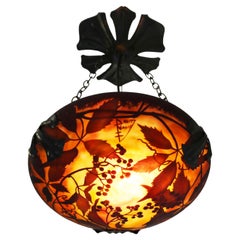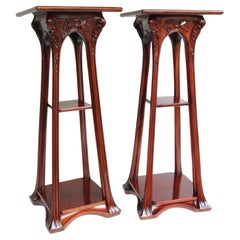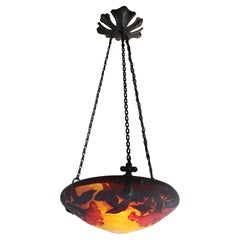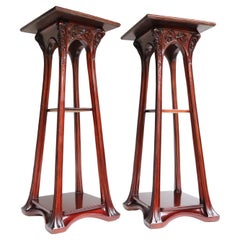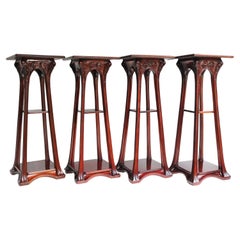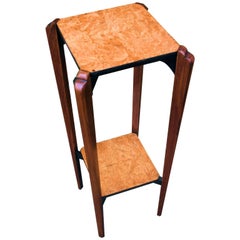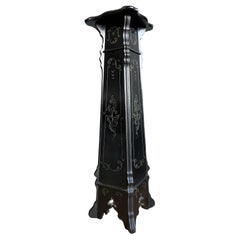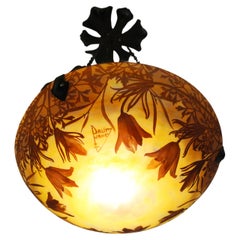Louis Majorelle Furniture
Louis-Jean-Sylvestre Majorelle, more commonly known as Louis Majorelle, was a French artist, metalworker and Art Nouveau designer celebrated for his bedroom furniture, cabinets, chairs and decorative objects.
In 1877, Majorelle moved to Paris from the town of Nancy where he began his studies in painting under Jean-François Millet at the École de Beaux Arts. Following the death of his father, a furniture designer, he returned to Nancy and took over the family workshop. Parisian architect Henri Sauvage designed Majorelle’s house in Nancy, Villa Majorelle, which featured stained glass by Jacques Gruber.
In order to increase productivity and reduce costs — as well as shift the family business’s focus from reproductions of 18th-century furniture such as Louis XV chairs to instead working in the era’s Art Nouveau style — Majorelle integrated modern techniques and processes at his atelier (these changes were in part inspired by innovative glassmaker Emile Gallé).
The workshop became known for Majorelle’s distinctive designs and the pronounced craftsmanship of its offerings. There were tables made from mahogany and ormolu that featured handsome bronze mounts and marquetry, table lamps that shared common ground with the prized designs associated with Tiffany Studios, and decorative pieces that Majorelle produced in partnership with Daum, a revered manufacturer of French art glass.
The work was very much characterized by the botanical motifs and curvaceous silhouettes of Art Nouveau design, and the business was successful. Majorelle produced a range of items during the early 1900s and was a participant in the 1900 Paris Exposition as well as the Exposition de l'Ecole de Nancy in 1903.
In 1916, a devastating fire broke out in Majorelle’s factory on the rue du Vieil-Aître in Nancy. It destroyed all of the company’s awards, sketches, molds, equipment and archives of Majorelle’s work. In 1917, destruction again shook his business when his shop on the rue Saint-Georges was bombed by German aircraft. The designer marched on — he relocated to Paris where he shared a workspace and created vases and other vessels in the Art Deco style before he moved back to Nancy. Majorelle designed the Nancy Pavilion at the International Exhibition of Modern Decorative and Industrial Arts in 1925 with Alfred Lévy. He died in 1926.
Find antique Louis Majorelle cabinets, seating and decorative objects on 1stDibs.
Early 1900s French Art Nouveau Antique Louis Majorelle Furniture
Wrought Iron
Early 1900s French Art Nouveau Antique Louis Majorelle Furniture
Wood
1910s French Art Nouveau Vintage Louis Majorelle Furniture
Wrought Iron
Early 1900s French Art Nouveau Antique Louis Majorelle Furniture
Wood
French Art Nouveau Louis Majorelle Furniture
Mid-20th Century French Art Deco Louis Majorelle Furniture
Maple, Walnut
Early 20th Century European Arts and Crafts Louis Majorelle Furniture
Wood, Beech, Paint
1880s Chinese Chippendale Antique Louis Majorelle Furniture
Wood, Hardwood
19th Century Victorian Antique Louis Majorelle Furniture
Wood
Early 20th Century Czech Art Nouveau Louis Majorelle Furniture
Wood
Early 1900s Dutch Art Nouveau Antique Louis Majorelle Furniture
Oak
Early 1900s French Art Nouveau Antique Louis Majorelle Furniture
Wrought Iron
1930s French Art Deco Vintage Louis Majorelle Furniture
Oak
Late 20th Century Chinese Chinese Export Louis Majorelle Furniture
Rosewood
Early 20th Century French Art Nouveau Louis Majorelle Furniture
Crystal, Brass
1910s Austrian Art Nouveau Vintage Louis Majorelle Furniture
Metal
Early 20th Century French Art Nouveau Louis Majorelle Furniture
Bronze
Early 1900s French Art Nouveau Antique Louis Majorelle Furniture
Wrought Iron
Early 1900s French Art Nouveau Antique Louis Majorelle Furniture
Walnut
Early 1900s French Art Nouveau Antique Louis Majorelle Furniture
Walnut
1910s French Art Nouveau Vintage Louis Majorelle Furniture
Marble, Brass
1910s French Art Nouveau Vintage Louis Majorelle Furniture
Wrought Iron
Louis Majorelle furniture for sale on 1stDibs.
Creators Similar to Louis Majorelle
- 1stDibs ExpertNovember 4, 2024To identify Louis XVI chairs, first familiarize yourself with the characteristics of the design style by looking at images found on trusted online resources. Often, Louis XVI chairs rest on straight, column-like legs, and their frames show off intricate carvings such as scrollwork rosettes, fluting and ribbon twists. Typically, chairs from the era have recessed arms connected to the front of the seat via an elegant curve. Artisans of the period typically constructed chairs in mahogany, walnut or oak wood. If your chair has these features, it will likely be an original Louis XVI piece or a reproduction based on one. To tell antiques apart from contemporary chairs, consider their overall condition.
Due to their age, originals will likely show some signs of wear, and you may be able to spot visible tool marks or slight irregularities in the carvings due to their handcrafted origins. A chair that looks unused and is completely uniform with no tool marks is less likely to be an original. When in doubt, check with a certified appraiser or experienced antique dealer.
On 1stDibs, find a selection of Louis XVI chairs. - 1stDibs ExpertNovember 4, 2024To identify Art Nouveau furniture, first try to locate a maker's mark on the piece. You can then use it to research the maker with the help of information published in trusted online resources. Some makers, such as Charles Rennie Mackintosh, Louis Majorelle and Émile Gallé, are well-known for their Art Nouveau furnishings. If you determine that a maker identified with Art Nouveau produced your piece, it likely reflects the movement's characteristics, especially if it was made during the late 19th or early 20th centuries. You can also look for common features of Art Nouveau furniture, such as sinuous, organic and flowing lines; forms that mimic flowers and plant life; decorative inlays and ornate carvings of natural-world motifs such as insects and animals and the use of hardwoods such as oak, mahogany and rosewood. A certified appraiser or knowledgeable antique dealer can aid you with the identification process. Shop a diverse assortment of Art Nouveau furniture on 1stDibs.
